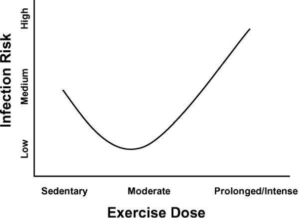Running from COVID-19: why exercise is so important during this pandemic

The effects of exercise are broad, mitigating diseases such as cancer, diabetes, cognitive disease and HIV. But researchers are just starting to piece together its effect on the trajectory of COVID-19.
To no surprise, the direction of the early evidence is in support of better strength, cardiovascular disease and generally better fitness for improved outcomes if you are infected. This conclusion may seem obvious to some, but why then is so little being said by leading health officials on the value of this message?
Knowledge is power, right?
Exercise and the immune system
The full profile of immune responses is beyond the scope of this article, and I am not an immunologist or a virologist, so I won’t even try to go there.
But the literature is conclusive that exercise triggers potent and wide ranging responses to the immune system.
Exercise is known to lead to the release of a barrage of anti-inflammatory cytokines, while at the same time holding back the release of some proinflammatory mediators. This is particularly beneficial for many chronic diseases where exercise can be used to battle chronic low-grade inflammation.
A recent editorial in the British Journal of Sports Medicine also outlined the value of our mitochondria in the function of our immune system, calling them energetic bug busters. Boosting our mitochondria’s capability through repeated, regular exercise may increase their viral bug busting capability as well. The authors propose that as cardiorespiratory fitness improves, our mitochondrial fitness improves as well which can mitigate viral infections.
Exercise intensity and immune function
The classic “J” curve on infection risk related to exercise shows the optimal dose of exercise is somewhere in the middle between sedentary and maximum intensity. Infection risk from this line of research comes from testing upper respiratory tract infections (ie colds, flu’s) in athletes, mostly runners.

Prolonged, high intensity exercise, is historically thought to cause a period of immune-suppression which may increase the risk of a respiratory infection. According to the International Society for Exercise and Immunology (ISEI), the immunological decrease occurs after 90 minutes of moderate- to high-intensity physical activity. Some experts say this period of immune-suppression lasts between 3-72 hours after high intensity exercise.
However, there are some concerns with the quality of the research that led to those conclusions. More recent research that has tested groups such as marathoners, elite rowers and national level swimmers have not found that athletes undergoing high training volume or training stress are at an increased risk for an URTI. When compared against control groups these athletes didn’t have any additional risk and may actually show a decreased risk.
As well, some animal models suggest the opposite may be true; that prolonged intense exercise confers immune benefits beyond sedentary controls. So the literature is conflicting and inconclusive regarding the role of high intensity, prolonged exercise.
Exercise and COVID-19
Preliminary evidence suggests that the severity of symptoms associated with COVID‐19 are associated with the health status of individuals prior to infection. The factors linked to an increased risk of hospitalization are overweight/obesity, insulin resistance, and diabetes; all metabolic lifestyle‐related diseases, characterized by patterns of sedentary behavior and a lack of physical exercise.
The Mayo clinic identified 246 patients who had a treadmill stress test between January 1, 2016 and February 29, 2020 and had a positive COVID test between February 29, 2020 and May 30, 2020. Maximal exercise capacity (measured in MET) was found to be significantly lower in patients who were hospitalized compared to those who were not hospitalized. Basically those who stopped sooner (with variables like age and weight considered) on the treadmill stress tests were at higher risk for more severe symptoms.
The theory is that a high level of cardiorespiratory fitness can reduce the early amplified proinflammatory response, called the cytokine storm, in patients infected and minimize serious symptom development. The better lung function in those with high cardiorespiratory fitness may also have served patients well in defending the attack on lung tissue.
A large recent survey study based out of California over 48000 patients who tested positive for COVID between January and October 2020 demonstrated that patients who were more sedentary had a greater risk of hospitalization, admission to the ICU and death due to COVID than patients who did “some” exercise. Those who consistently met physical activity guidelines (150 minutes of exercise per week) had even less risk than those who did some exercise.
This data comes from Kaiser Permanente health care system where for over a decade doctors and nurses have tracked exercise volume, number of days per week and amount of time for each session. For this study the researchers grouped subjects into the least active group exercising for 10 minutes or less most weeks to the most active group exercising for at least 150 minutes per week and a third group, the somewhat active group somewhere in between.
While the research was observational in nature and cannot by design elicit cause and effect conclusions, one of the researchers, Dr. Sallis, states that based on this data we can recommend that walking briskly for a half hour 5 times per should help protect them against severe COVID-19.
A large study on adults over the age of 50 from 27 European countries also demonstrated an association between grip strength and hospitalization due to COVID. Hand grip data collected between 2004 and 2017 using a handheld dynamometer was compared against self reported survey data sent to participants between June and September in 2020. 3600 respondents completed the COVID-share survey questions and 83 of those respondents had been hospitalized due to COVID-19. The authors state that this is just another demonstration of how skeletal muscle weakness can affect motor control, respiratory function and is linked to poor immune responses and metabolic stress when facing an acute infection.
These are the first couple of original research pieces to emerge. Just the beginning of connecting the dots from a theoretical framework into more specific exercise recommendations.
So yes, research is understandably limited (although we expect that to change soon). And we don’t have any data yet on whether regular exercise and better fitness levels help prevent becoming infected with COVID-19.
But we can protect ourselves against the severe morbidity and mortality related to COVID-19, through regular, vigorous, physical activity. We look forward to updating this article as more evidence emerges; but in the meantime: get out, get active, push your strength limits and get that heart pumping!
